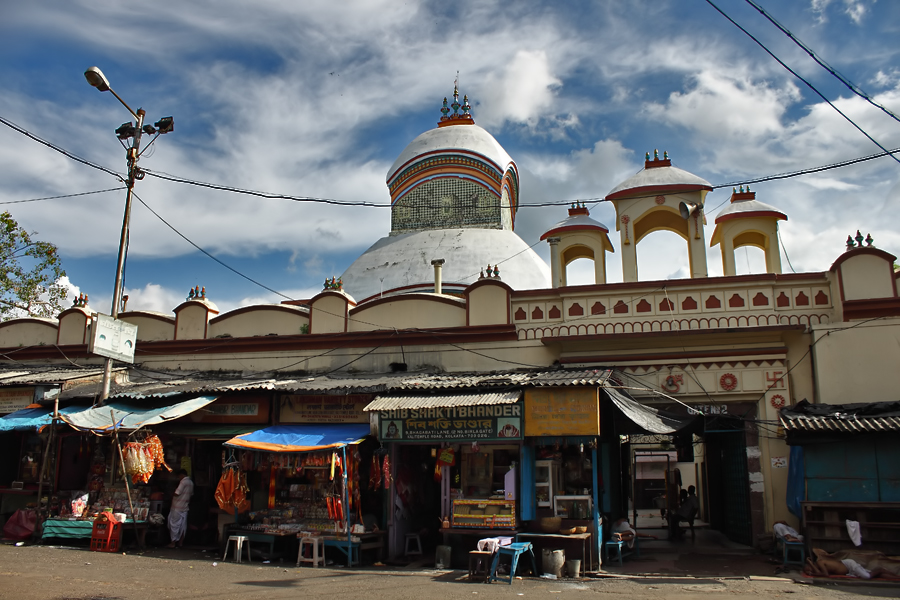The Kalighat temple in its present form is only about 200 years old, although it has been referred to in Mansar Bhasan composed in the 15th century, and in Kavi Kankan Chandi of the 17th century.
There is a 3 ft high rectangular alter where 3 stones are kept under a tree. These stones represent Sasthi, Shitala and Mangala Chandi - part of Ma Kali. This spot is called Shasthi Tala or Manasha Tala.
There are no male priests in this area. Adjacent to the temple lies the Natmondir - a covered platform from where the main deity can be seen. Next to this lie the two sacrificial altars. A separate shrine dedicated to radha Krishna is also present within the complex.
A sacred tank called Kundupukar lies in the south east corner of the temple complex. The right tow of Sati is believed to have been found in this area. The water of this tank is considered to be as holy as Ganga and has the power to bestow the boon of a child.
Kalighat Kali Temple is a Hindu temple in West Bengal, India dedicated to the Hindu goddess Kali.It is one of the 51 Shakti Peethas.Kalighat was a Ghat (landing stage) sacred to Kali on the old course of the Hooghly river (Bhāgirathi) in the city of Calcutta.
The name Calcutta is said to have been derived from the word Kalighat. The river over a period of time has moved away from the temple. The temple is now on the banks of a small canal called Adi Ganga which connects to the Hoogly.
Being one of the Shakti Peeths, the story of Kalighat is related to the Daksha Yagya and Satis self immolation. It is said, during Shiva?s Tandav dance of destruction throughout the universe, Sati's right toe had fallen where the temple stands today.
Years later a passing devotee caught sight of a light coming from the Bhagirathi river (Hoogly) and on inspection found the source to be a stone carved in the form of a toe. He also found a Shivaling of Nakuleshwar Bhairav nearby. After that he took to worshipping Kali in a jungle. Kalighat is also associated with Chowringi Nath, a Dasanami monk who prayed to Goddess Kali.
Kalighat is regarded as one of the 51 Shakti Peethas of India, where the various parts of Sati's body are said to have fallen, in the course of Shiva's Rudra Tandava. Kalighat represents the site where the toes of the right foot of Dakshayani or Sati fell.
Legend has it that a devotee discovered a luminant ray of light coming from the Bhāgirathi river bed, and upon investigating its source came upon a piece of stone carved in the form of a human toe.
Do:
- Do pray your Ishta Devata before pilgrimage to Temple.
- Do contact Temple Devasthanam information centre for enquiry, temple information and for Pooja details etc.
- Do reserve your travel and accommodation at Temple well in advance.
- Do bath and wear clean clothes before you enter the temple.
- Do concentrate on God and Goddess inside the temple.
- Do maintain silence and recite your Istamantram to yourself inside the temple.
- Do observe ancient custom and traditions while in Temple.
- Do respect religious sentiments at Temple.
- Do deposit your offerings in the hundi only.
Don't s:
- Do not come to Temple for any purpose other than worshipping of God and Goddess.
- Do not smoke at Temple.
- Do not consume alcoholic drinks at Temple.
- Do not eat non-vegetarian food in the Kshetram.
- Do not approach mediators for quick Darshanam. It may cause inconvenient to others.
- Do not carry any weapon inside the temple.
- Do not wear any head guards like helmets, caps, turbans and hats inside the temple premises.
- Do not perform Sastanga Pranama inside the Sanctum Sanctorum.
- Do not take much time while performing Sparsa Darshanam to God in Garbhagriha.
- Do not buy spurious prasadams from street vendors.
- Do not encourage beggars at Temple.
- Do not spit or create nuisance in the premises of the temple.
